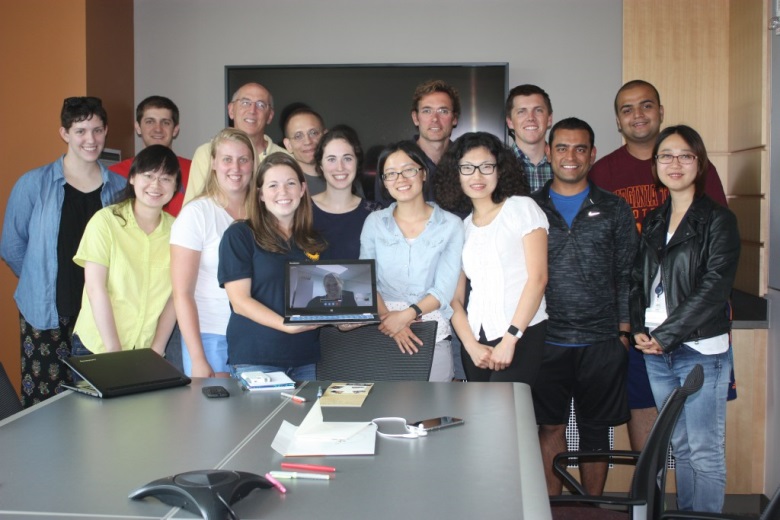“We were extremely concerned”-researches for lead-in-water contamination in Flint, Michigan

Professor Marc Edwards and his research team, some of whom have ties to the Water INTERface IGEP, gave a presentation at 7 p.m. Thursday night, Jan. 28, in Blacksburg to outline their internationally recognized work — done in collaboration with Flint, Michigan, residents — that exposed widespread lead-in-water contamination. The presentation provided an overview of the Flint Water Study team’s efforts combining ethics, engineering, citizen science, laboratory experiments, investigative science, and social media to confirm the high lead levels in Flint’s water (as reported by Lindsey Haugh). The complete video of their presentation can be found at: https://www.youtube.com/watch?v=AVHE5ny0MBg.
Background
A newly constructed water pipeline in Flint and other counties in Michigan has caused serious lead contamination in the tap water due to unmitigated corrosion caused by the Flint River water. The tap water contamination has led to various health problems for Flint residents, especially for young children. In early 2015, Flint resident LeeAnne Walters’ four-year-old son broke out in scaly rashes and her 14-year-old son became extremely sick and missed a month of school. Other Flint residents also complained of various illnesses, likely related to the rusty red-water coming out of the tap after the newly constructed water pipeline began to be used. However, the local residents were repeatedly told by workers at the Michigan Department of Environmental Quality that there was nothing to worry about. LeeAnne Walters, a concerned mother who could not get any help or attention from state or local officials, called Edwards, a faculty member with affinity to the Water INTERface IGEP at Virginia Tech and who is widely-known for his work that brought to light water quality issues in Washington, D.C. and for winning a MacArthur Fellowship in 2007.
What Water Interface Members Did
Professor Marc Edwards and students – some of whom are active with the Water INTERface IGEP at Virginia Tech and who are in research fields including civil engineering, water chemistry, and microbiology – formed the Flint Water Study Team, volunteering their time, resources and expertise to help resolve the scientific uncertainties of the drinking water issues being reported in Flint, MI. After taking samples in 277 homes and with assistance from the Flint citizen activists, the research team has found that Flint’s water supply is suffering from serious lead contamination as well as bacteria problems. Independent research by Hurley Medical Center (Dr. Mona Hanna-Attisha) and the Genesee County Health Department later discovered higher levels of lead poisoning in children and an outbreak of Legionnaire’s disease (which resulted in 9 deaths).
“We were extremely concerned,” said William Rhoads, a doctoral student of Dr. Edward’s team. “On average there was 133 times more lead in her water than the maximum allowable.” “Lead is the best known neurotoxin, it adversely impacts every system in the human body,” said Dr. Edwards. When water sits in those pipes, lead can leach into the water. But without corrosion control, even more lead leaches into the potable water. For 18 months, 10,000 residents were exposed to toxic water,” said Siddhartha Roy, a civil engineering graduate student and communications director for the Flint Water Study Team. “They did nothing to deserve this. Nine thousand kids were exposed.”
Achievements
The role of Dr. Edward’s team to uncover the problem has been widely reported by media around the world. The on-going goals of the team are: 1) to study impacts of water age and current water quality on Flint’s water distribution systems as well as issues of elevated lead and opportunistic pathogens in premise plumbing (OPPPs); 2) to support and educate citizen scientists concerned about public health; and 3) to inform decision making and policy considerations.
As a result of the research results of Dr. Edward’s team, President Obama declared a state of emergency in Flint, and nearly $100 million has been committed to aid Flint in relief and recovery. Dr. Edwards said “we now feel that Flint’s kids are finally on their way to being protected and decisive actions are under way to ameliorate the harm that was done.” “I found the pipe in 2005* and I said I would never let this happen to another child, so help me,” Edwards said.
It’s been a long journey,” Walters said. “Thank you to Marc and the students at Virginia Tech, but the thanks isn’t just from me. It’s from all the people of Flint. The fact is, they cared more about us than the city and the state, and it is something we will always hold close to our heart.”
Sid Roy, from the Flint Water Study team and Water INTERface IGEP, traveled to Columbus OH to present about Flint at the Ohio AWWA Safe Drinking Water Act seminar on November 12, 2015 courtesy of a Water INTERface IGEP travel grant.
Members of Water INTERface program in Flint Water Study team include:
- William Rhoads of Joplin, Missouri;
- Anurag Mantha of Hyderabad, India;
- Pan Ji of Xianyang, China;
- Siddhartha Roy of Palanpur, India;
- Professor Amy Pruden, Virginia Tech.
*Dr. Edwards has been working with lead-in-water contamination in Washington, D.C. since 2005 and dedicate for children’s environmental health initiatives.



